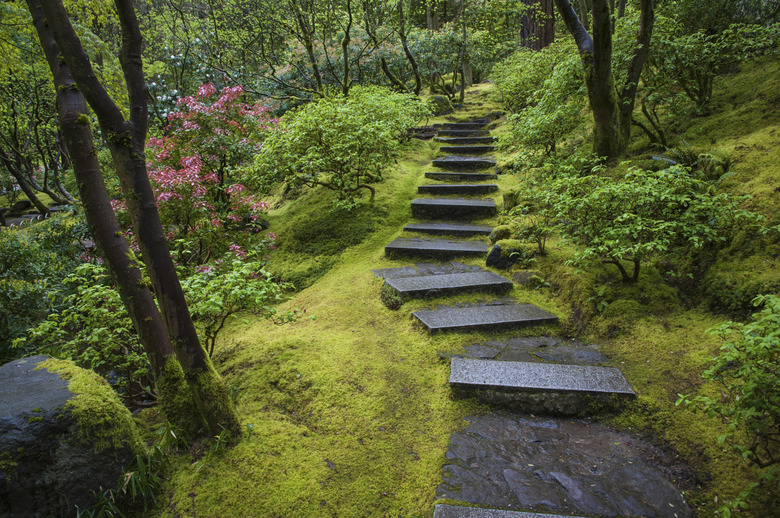Diseases In 'Sky Pencil' Holly
"Sky Pencil" holly (Ilex crenata "Sky Pencil"), a cultivar of Japanese holly, has a distinctive tall, columnar shape that works especially well for narrow spaces such as entryways. It grows in U.S.
"Sky Pencil" holly (Ilex crenata "Sky Pencil"), a cultivar of Japanese holly, has a distinctive tall, columnar shape that works especially well for narrow spaces such as entryways. It grows in U.S. Department of Agriculture plant hardiness zones 6 through 8, and grows easily in well-draining soil that receives full sun to partial shade. While "Sky Pencil" holly doesn't need significant maintenance, this evergreen is susceptible to several diseases that can stunt its growth or kill it. Being able to identify the most common diseases means you can start treatment quickly.
Black Root Rot
Black root rot, caused by the fungus Thielaviopsis basicola in "Sky Pencil" holly and other Japanese hollies, attacks the root system. Affected plants have dark brown to black roots where the fungus is growing in or on the root tissue. Areas where the roots have begun to decay also appear discolored. The plants often show signs of decline over the course of several months and usually die during or just after dry periods. The fungal spores can remain in the soil for years, particularly if the soil is moist and cold. The spores are carried by wind, water, garden equipment and infected plants. If you've lost "Sky Pencil" holly plants to black root rot, use the area for other shrubs that are resistant to the disease. To prevent black root rot, plant in well-draining soil or plant the hollies in raised beds.
- "Sky Pencil" holly (Ilex crenata "Sky Pencil"), a cultivar of Japanese holly, has a distinctive tall, columnar shape that works especially well for narrow spaces such as entryways.
- The fungal spores can remain in the soil for years, particularly if the soil is moist and cold.
Botryosphaeria Canker
Botryosphaeria canker usually affects "Sky Pencil" holly and other Japanese holly cultivars that have been exposed to extremely low or high temperatures or have experienced extreme drought conditions. Healthy plants don't usually have problems with this disease. Early symptoms include yellowing and dropping of the leaves and dieback of the twigs. Cankers also appear as sunken, cracked areas of brown or black discoloration on the twig bark. The tissues surrounding the canker can also become discolored and bark may fall off. To treat a "Sky Pencil" holly plant with Botryosphaeria canker, prune the affected twigs and burn the infected pieces, if possible. Disinfect the pruning tools by soaking them in a solution of 1 part household bleach to 9 parts water for 10 minutes or dip the tools in 70 percent alcohol and allow them to dry. To prevent the disease, water "Sky Pencil" holly plants regularly. If your soil drains poorly, plant the holly in a raised bed. Add mulch, such as pine straw or aged bark, around the plants to prevent injury to the bark when mowing the lawn and to help keep the soil moist.
- Botryosphaeria canker usually affects "Sky Pencil" holly and other Japanese holly cultivars that have been exposed to extremely low or high temperatures or have experienced extreme drought conditions.
- To treat a "Sky Pencil" holly plant with Botryosphaeria canker, prune the affected twigs and burn the infected pieces, if possible.
Nematodes
Microscopic parasitic worms, nematodes can infest "Sky Pencil" holly plants. They're more of a problem in sandy or sandy loam soils. Several different types of nematodes may affect "Sky Pencil" holly, including root-knot, stunt, sting, ring, lesion, lance and spiral nematodes. The parasites live in organic material in the soil surrounding the plants or within the plants' roots, and attack the root systems. Symptoms include stunted growth, yellow leaves, leaf loss, poor response to water and fertilizer and stem dieback. Nematodes are most likely to be in the soil of old vegetable gardens, so avoid planting "Sky Pencil" holly in those areas. If the hollies show signs of nematodes, remove the tree as well as the surrounding soil and avoid planting holly in that area in the future.
- Microscopic parasitic worms, nematodes can infest "Sky Pencil" holly plants.
- Nematodes are most likely to be in the soil of old vegetable gardens, so avoid planting "Sky Pencil" holly in those areas.
Phytophthora Root Rot
If you plant a "Sky Pencil" holly in poorly draining soil, it may develop Phytophthora root rot. The disease usually affects container plants. Infected plants show symptoms including wilted leaves with dull green, red, purple or yellow discoloration; twig dieback; and slowed growth. Bark at the soil line may appear darker in color. The fungus that causes the rot can survive in soil for years if the soil remains moist. The fungal spores can be spread through water, contaminated garden tools and soil. Phytophthora root rot is more likely to spread during cool, moist weather in early spring or late fall. To prevent the disease, make sure the holly's beds or containers have good drainage and avoid overwatering the plants.
- If you plant a "Sky Pencil" holly in poorly draining soil, it may develop Phytophthora root rot.
